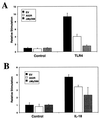A46R and A52R from vaccinia virus are antagonists of host IL-1 and toll-like receptor signaling
- PMID: 10920188
- PMCID: PMC27775
- DOI: 10.1073/pnas.160027697
A46R and A52R from vaccinia virus are antagonists of host IL-1 and toll-like receptor signaling
Abstract
Poxviruses employ many strategies to evade and neutralize the host immune response. In this study, we have identified two vaccinia virus ORFs, termed A46R and A52R, that share amino acid sequence similarity with the Toll/IL-1 receptor (TIR) domain, a motif that defines the IL-1/Toll-like receptor (TLR) superfamily of receptors, which have a key role in innate immunity and inflammation. When expressed in mammalian cells, the protein products of both ORFs were shown to interfere specifically with IL-1 signal transduction. A46R partially inhibited IL-1-mediated activation of the transcription factor NFkappaB, and A52R potently blocked both IL-1- and TLR4-mediated NFkappaB activation. MyD88 is a TIR domain-containing adapter molecule known to have a central role in both IL-1 and TLR4 signaling. A52R mimicked the dominant-negative effect of a truncated version of MyD88 on IL-1, TLR4, and IL-18 signaling but had no effect on MyD88-independent signaling pathways. Therefore, A46R and A52R are likely to represent a mechanism used by vaccinia virus of suppressing TIR domain-dependent intracellular signaling.
Figures





Comment in
-
Viral interference with IL-1 and toll signaling.Proc Natl Acad Sci U S A. 2000 Sep 26;97(20):10682-3. doi: 10.1073/pnas.97.20.10682. Proc Natl Acad Sci U S A. 2000. PMID: 11005852 Free PMC article. No abstract available.
References
-
- Moss B. In: Virology. Fields B N, Knipe D M, Howley P M, Chanock R M, Melnick J, Monath T P, Roizman B, Straus S E, editors. Vol. 2. New York: Lippincott–Raven; 1996. pp. 2637–2671.
-
- Alcamí A, Symons J A, Khanna A, Smith G L. Semin Virol. 1998;5:419–427.
-
- Smith G L, Symons J A, Alcamí A. Semin Virol. 1998;8:409–418.
-
- O'Neill L A J, Greene C. J Leukocyte Biol. 1998;63:650–657. - PubMed
MeSH terms
Substances
LinkOut - more resources
Full Text Sources
Other Literature Sources
Miscellaneous

